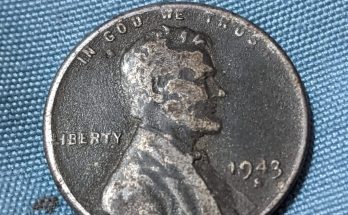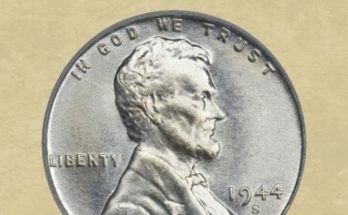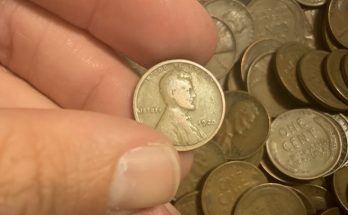The Jefferson nickel’s 1938 debut marked the end of the 25-year production run of the Buffalo nickel. James Earl Fraser’s Buffalo design, a classic in terms of coin art and Americana, gave the Mint fits. It was a difficult coin to strike, was hard on dies, and the speed at which the coin’s date wore off in heavy circulation meant replacing the design became a Mint priority once the design met the 25-year statutory limit for change.
Given the 1909 release of the Lincoln cent marked the centennial of the birth of the Great Emancipator and the 1932 release of the Washington quarter marked the bicentennial of the birth of America’s first president, one might assume that Jefferson was chosen in 1938 to mark an anniversary of his birth year. However, Jefferson was born in 1743, so this is not the case.
Instead, Jefferson was likely selected due to his importance as a Founding Father. He authored the Declaration of Independence, helped devise the American monetary system, spent the country’s first coinage struck by the United States Mint (coincidentally a five-cent coin called a half disme), and served the nation’s third president.
The Mint announced a design competition to come up with a Jefferson design for the nickel on January 25, 1938. In April, as the final Buffalo nickels were rolling off the presses at the Denver Mint, the competition judges selected Felix Schlag’s Jefferson designs. The obverse of the submitted designs featured the familiar Jefferson side profile portrait probably taken from Jean-Antoine Houdon’s 1789 bust of Jefferson. The reverse featured an innovative three-quarters perspective of Jefferson’s mansion Monticello. This perspective on Jefferson’s home was rejected by the Treasury Department, which communicated to Schlag a series of revisions that had to be made.
The most consequential changes were ordered for the reverse. The Mint wanted a straight-on view of the edifice, as most Americans were unfamiliar with Jefferson’s architectural home. In fact, Monticello had fallen into a state of disrepair in the decades following his death and if it hadn’t been for the efforts of businessman Uriah Phillips Levy and property caretaker Joel Wheeler, it’s doubtful that the structure would have survived long enough to have been photographed.
By mid-July, Schlag’s final design revision had been submitted and Mint Chief Engraver John R. Sinnock was hard at work preparing hubs and dies. Trial strikes were executed in September and on October 3, the new Jefferson nickel went into production at all three Mints. By the end of the month, the Denver Mint had struck 1,700,000 pieces. By year’s end, Denver would produce 5,376,000 Jefferson nickels. The new coins would be released into circulation after a November 15 Treasury authorization.
1938-D Jefferson Nickel Production Characteristics
5,376,000 Jefferson nickels dated 1938 were struck at the Denver Mint. The coins did not enter circulation until the end of the year, and despite some enthusiasm from collectors and the general public, the issue circulated as intended and remained readily available in change through the 1960s.
Coin production exploded after that and the preponderance of coins struck in recent years made the probability of finding an early date more and more unlikely in change. Still, the 1938-D is a common-enough coin in all circulated and Mint State grades through MS-65, even though it does boast the fourth-lowest mintage for the series.
In terms of strike characteristics, the 1938-D–like the 1938-(P) and the 1938-S–is a Jefferson nickel that is best described as inconsistent. Still, of the three Mints, Denver probably produced the nicest Jefferson nickels of all three mints in 1938. This is not an issue that is particularly difficult to acquire with Full Steps designation, but fully struck examples are the exception and not the rule. These are coins that were struck from fresh hubs and the true difficulty of finding well-struck examples would not become apparent until the 1950s and ’60s.
Earning the Full Steps Designation
To earn the designation of Full Steps, a Jefferson nickel must meet the following criteria:

In this graphic, you see that the steps, located on the design between the stylobate, a flat pavement section on which rest the four front columns of the design, and the foundation block at the base of the steps. Factors such as die condition, striking pressure, and incidental contact with other coins, play a significant factor in whether a Jefferson nickel will earn the Full Steps designation.
How Much Is the1938-D Jefferson Nickel Worth?
What is a 1938-D Jefferson nickel worth? In circulated grades, the 1938-D is worth about $2.50 USD. In uncirculated conditions, a collector should expect to pay a minimum of $10.00 for an uncirculated example in a 2×2 flip, upwards to $550 to $600, or more, for an example in Superb Gem with Full Steps.
Graded examples are most commonly found in the 64 to 65 range, with 66 also well represented. With Full Steps, PCGS has certified 28 in MS-64, 181 in MS-65, a total of 363 in MS-66, 104 in MS-67, and seven in MS-68 (one a toned MS68+) as of the time of this writing (October 2021). In contrast, NGC reports populations of four in MS-64, 41 in MS-65, 104 in MS-66, 44 in MS-67, and five in MS-68.
In January 2014, Heritage Auctions sold a PCGS MS67+FS example for $4,993.75. This coin had light blue and golden toning- typical for nickels. At the time of the sale, the coin was a top pop coin with just 37 coins graded at the MS67 FS level. Today, the population of this modern issue has increased significantly and this particular example lost more than 77% of its equity when Legend Rare Coin Auctions sold it for $1,145.63 in July 2020.
In April 2020, a darkly toned PCGS MS68 FS sold for $3,900 in a Heritage sale. Six months later, another pleasing PCGS MS68 FS sold through Heritage for $2,640.
Design
Obverse:
A left-facing bust of President Thomas Jefferson, including a colonial-era pigtail and strikingly similar in detail to the profile of Jean-Antoine Houdon’s 1789 bust, takes up the majority of the obverse. The top of his head almost touches the rim, and the barest of truncations is visible at the bottom where Jefferson’s left shoulder meets the edge of the coin. The motto IN GOD WE TRUST–which became the national motto in 1956–arcs clockwise along most of the length of the left side of the coin, starting from Jefferson’s chest and extending to his hairline. The inscriptions LIBERTY and the date 1938 run clockwise along the right side behind Jefferson. A small five-pointed star divides the two inscriptions.
Reverse:
The reverse features a front view of Monticello, Jefferson’s mansion near Charlottesville, Virginia. The polymath Jefferson designed the neoclassical building himself, based on architectural principles from the Italian Renaissance; the name “Monticello” comes from the Italian for “mound” or “little mountain”. The building loses much of its dimensionality in the flattened rendering, but the octagonal nature of the dome can still be interpreted, and better strikes reveal significant detail in the steps and portico.
Atop the reverse is the motto E PLURIBUS UNUM (“Out of Many, One”). The name MONTICELLO–the placement of which on the coin was one of the revisions forced upon Schlag by the Mint–is found in a straight line immediately under the building; the positions and spacing of the other inscriptions had to be adjusted to make room for it. The denomination FIVE CENTS forms a gently curving line beneath that, and the inscription UNITED STATES OF AMERICA runs counterclockwise along the bottom edge of the coin.



